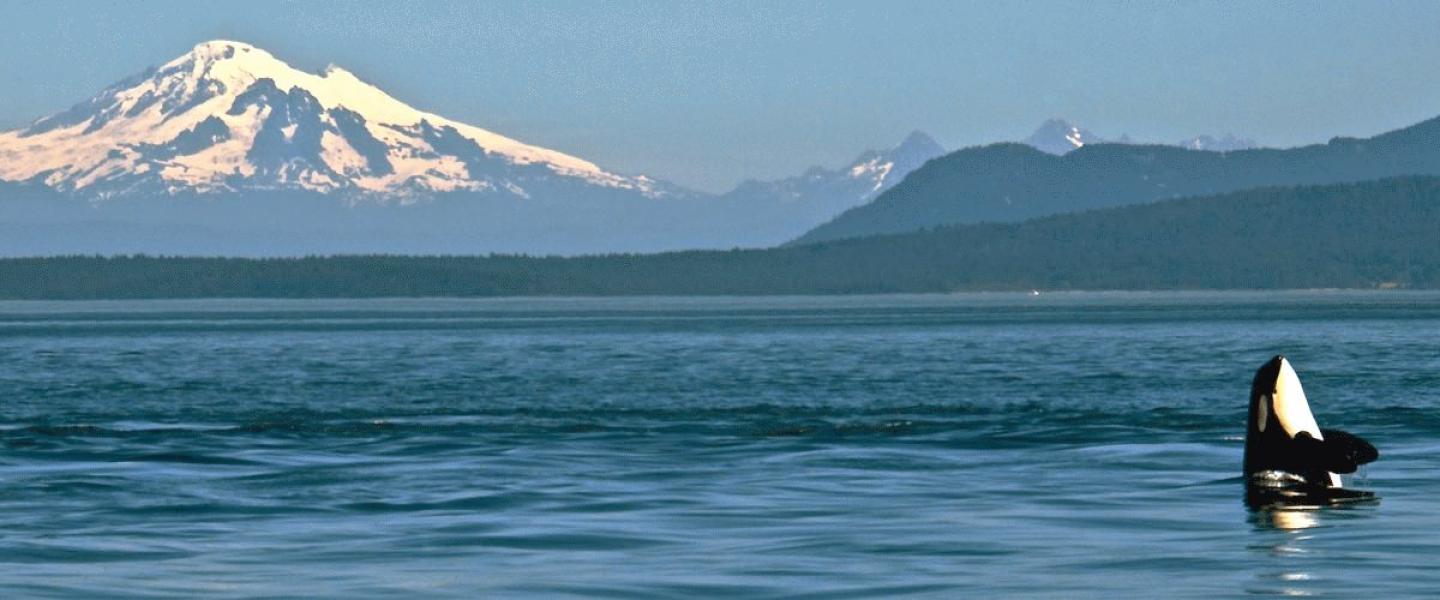
Today October was showing it's true colors over the Salish Sea in the form of an incredibly serene mist that hung in the form of clouds over hilltops and muted all the normally seen colors. Not a breath of wind was felt on this classic Pacific Northwest morning in Friday Harbor, and Captain Mike and I were looking forward to taking our passengers out on the Sea Lion for this unique experience.
As we left the dock with a boat full of passengers ready to embrace the mystique of the misty island atmosphere and the wildlife that we might encounter, we headed East towards Shaw island. We immediately encountered first a bald eagle on the shore of Shaw and simultaneously a huge Stellar's sea lion popped up behind the boat! Each distinctive breath the enormous animal took as it swam North was clearly audible in the still air.
We decided to explore off the beaten track a bit and headed East in between Lopez and Shaw islands and down to Thatcher Pass, between Decatur and Blakely islands. It was here we bagan our search, as we had heard reports of a humpback whale in the area.
It turned out the report was wrong. There were TWO humpbacks! In the distance we saw one enormous fluke rise into the air followed by a much smaller one as the mother and calf pair dove together.
The ol' Sea Lion zipped over to get a closer look and suddenly we heard and saw a pair of blows erupting from the water as mom and her baby surfaced together. This baby will be less than a year old. We know this from observing humpback whales all over the world since the early 1970's. Mothers will feed all summer long in northern climates like the coasts of Washington, British Columbia and Alaska. When fall comes, they will begin the twenty-five hundred mile migration to southern latitudes and tropical climates, where the water is warm enough to have one whale of a baby. The newborn calf will weigh in at about eight feet long and just under one ton, blubberless but ready to breathe and begin swimming. The first months of life will be spent nursing from very fatty milk that mom has produced, fueled by her rich diet while feeding in the north. This young whale will put on weight at an astounding rate, gaining several thousand pounds in the first months of life. Once spring rolls around and mother whale is ready to head north and begin eating again after her long fast, her calf will follow and learn the migration route. Once safely in the north, after potentially facing transient killer whales along the way, mom will begin to teach this youngster how to eat like she does: by engulfing huge amounts of water saturated with fish and straining it through their baleen.
After nursing and feeding together all summer long, this calf will be nearly independent. All that remains is to learn the southern migration route back to tropical seas. However, after following mom back down south they will part ways. Mother whale may decide to get pregnant again, or may even deliver another baby! meanwhile her calf will be independent at this point and may journey back to the north to feed and feed and feed until it is ready to mate, at round eight or nine years old.
Knowing this cycle lead us to appreciate the short but intense relationship of this mother humpback to her calf as we watched them breathe at the surface and then dive, showing their flukes once more. After watching a few more rounds of their necessary trips to the surface to breath, we decided to explore the area a bit and see what other wonders were waiting in the mist.
To the north of Blakely Island lie a small group of islands that look, especially with the subtle greys, blues, greens and blacks of the misty day, like they ought to be off of the north coast of Scotland. These tiny islands with their high bluffs all around are known as the Cone islands, and they are a truly mythical sight to behold. Abundant kelp forests with local harbor seals, cormorants and seagulls surrounded these lonely peaks at which we were able to take a peek.
After sufficiently exploring, we made our way back to where we left our pair of humpbacks and after searching, and searching, and searching! we finally found them! the timing could not have been better, as the baby decided to begin rolling around playfully. We saw fins in the air as well as flukes as the youngster, who can't yet hold its breath quite as long as mom can, waited for its mother to return to the surface. As she did, we saw a few bubbles emerge at the point on the water where, several seconds later, her massive blowholes emerged and released a billow of water vapor into the air. This literal column of steam hung in the air as if it was placed there while her and her baby arched their backs and showed us their flukes one last time as they dove together.
It was time for us to call that the Tail end of our show (Hardy har har) and begin making our way back west towards Friday harbor. Along the way we got some great looks at more of the seemingly omnipotent harbor seals as well as a myriad of different seabirds.
Another Whale of a Day in the San Juan Islands!
Naturalist Mike J
M/V Sea Lion
San Juan Safaris